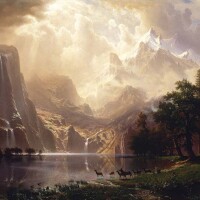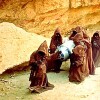The Protected Petroglyphs of China Lake Naval Base

The greatest (meaning both the largest and the best preserved) concentration of Native American rock art in the country is only about a hundred miles north of Los Angeles. And it’s a beautiful drive too, through canyons and high desert valleys, sweeping vistas and surreal rock formations on the approach to the town of Ridgecrest and the dry sand bed of China Lake. As in China Lake Naval Base. And that’s where things get interesting.
In the canyons and plateaus of the Coso Mountains are thousands of images left by the Coso native people who once populated this region. Not much is certain about this hunter-gatherer society, but when gold and other minerals were discovered in California, settlers staked their claim on this land. Skirmishes with the Coso peoples led the U.S. Army to forcibly evict nearly 900 Indians from the area in 1863. The dispersal of the population continued again when the City of Los Angeles purchased much of their land.
The petroglyphs are carved into the rocks, and range in age from Paleoindian times to the present, with some as old as 12,000 years. Imagery ranges from sheep, lizards, mountain lions and snakes, to people, ceremonial objects, rain, fire and abstract patterns representing the cosmos.There are many theories as to why these images exist. Some say it was a part of a hunting ritual, while others believe the petroglyphs are a result of altered states of mind.
This treasure trove is located on the Naval Air Weapons Station, China Lake, a major research, development, test and evaluation facility active since 1943. Public access is permitted to many of these petroglyphs but is limited to tours with Navy-approved guides — and interestingly, not open at all to foreign nationals, because it’s an active military intelligence site. Last year they hosted about 650 people in 37 total tours. There’s a Department of Defense visitor application packet online that looks pretty intense. So there’s that. But eccentric logistics aside, it’s worth taking a moment to unpack this unusual custodial arrangement.


It feels a bit counterintuitive to think of a military installation, particularly one which frequently hosts live weapons testing events, as the protectors of cultural anthropology and fragile ecosystems. The truth is, in the beginning it was probably a happy accident. The Navy needed a remote location and a barrier of depopulated land. Their presence ensured the site would never be overrun with rogue tourists, developers, vandals or industrial pollution. Cooperation ensued. Whatever the decision-making process was back in 1943, soon enough they became cognizant of what they had and then proud of it, and it seems to be working out. The official military statement states clearly, that “NAWS China Lake firmly believes that the petroglyphs located within the installation are a treasure and should be shared.”
At this point, a network of cultural, educational and governmental organizations and agencies are stakeholders in the dispensation and management of the site, each with slightly different priorities. And yet in a rare example of confluence befitting such a sacred site, these directives not only do not compete but rather overlap and enhance each other. Even — or some might argue, especially — the military’s. The Maturango Museum on the site is an information center for Death Valley National Park, the Eastern Sierra Mountains and places of local historical and geological interest. The National Park Service has a hand in things, and they work closely with the Bureau of Land Management and the Forest Service. The site has even attracted the attention of international organizations like very fancy Geneva-based Bradshaw Foundation, whose cultural heritage site preservation exists, “to discover, document and preserve ancient rock art around the world, and promote the study of early mankind’s artistic achievements.” Even though they don’t actively work with China Lake, they produced this gorgeous video for their online archives.
But even with all of that, and the Navy very much in charge, the public’s only true access point into the canyons is the Maturango Museum. Founded by prominent local residents connected to the Navy and the town of Ridgecrest starting in 1961, it was not necessarily focused on the petroglyphs, but rather on the broader strokes of local and natural history, regional art and craft, zoology, botany, paleontology and archaeology — all of which remain central to their year-round programming, embracing their role as the central hub for the array of tourists, scholars, military historians, artists and environmentalists who find their way to the canyon. We spoke to Archaeology Curator Alexander Rogers (who goes by Sandy) and members of the staff about how it all comes together.

Please tell me more about the role of the museum in the local community, among the regular folks who live and work in the area.
The museum is located in the town of Ridgecrest, which is home to the Naval Air Warfare Center (NAWC), one of the Navy’s largest laboratories and test range complexes. The population of Ridgecrest is approximately 27,000 and the NAWC is the major employer, with approximately 3,500 employees, mostly civilian scientists and engineers, with a high level of education. The Museum is a key center for the community, with various local and natural history and archaeological exhibits, an art gallery, events including the annual Wildflower Show and Artists’ Open Studio Tour, lectures, field trips, concerts, astronomy parties and children’s programs coordinated by the museum docents both in the museum and out at local schools. The Museum hosted approximately 25,000 people in 2017 including approximately 16,000 visitors in 2017, many of them international.
Can you please explain how the arrangement with the China Lake Naval Base works, in terms of restriction/protection of the canyon? Do they have a liaison with your organization?
The Museum has a memorandum of agreement with the Naval Air Weapons Station (NAWS), which manages the lands where the petroglyphs occur. The petroglyphs are part of the Coso Rock Art District National Historic Landmark, which encompasses 36,000 acres within the NAWS. Since the NAWS is an active military test range, access is controlled by the Navy and can only occur with Navy approval. The MOA governs our obligations and tour requirements regarding safety and security. We have a regular liaison with the NAWS Public Affairs Officer, as well as with other personnel on the Base. Our tour escorts undergo training at the Museum and certification by the Navy in safety and security procedures.
If you think you can pass the application process, last we checked there were still some tour spots available in May and June. If not, here are other places to check out around California.
Top Image: Anthropomorphic art at Coso Rock Art District National Historic Landmark | Courtesy of Maturango Museum
This article has been updated to identify the Coso native peoples are makers of these images, include a little more history on the region and theories on the origins of these petroglyphs.





